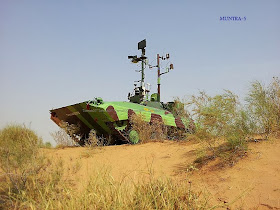By Anantha Krishnan M
Express News Service
Bangalore: The Combat Vehicles Research & Development Establishment (CVRDE), Avadi-based (near Chennai) DRDO lab, is warming up to take two of its unmanned ground vehicles (UGVs) for summer trials in the next two months. CVRDE Director Dr P Sivakumar told Express on Friday that the UGVs -- Muntra-N (designed for NBC -- Nuclear, Biological, and Chemical reconnaissance) and Muntra-M (designed for mine detection missions) are currently undergoing lab level trials at Avadi ahead of the summer trials. DRDO had exhibited Muntra-S (meant for surveillance) during the DefExpo in 2012 and the scientists say that the vehicle has already completed the desert trials successfully. Muntra stands for Mission Unmanned Tracked. Express News Service
Sanctioned with a seed money of Rs 60 crore in 2007, the project consists of four vehicles, with three in the unmanned role and the fourth one in a manned mode (Muntra-B), doing the base control duties. "Muntra-B will be common for all missions depending upon the role. In 2012, during the field trials, Muntra-S operated at very high temperatures in Rajasthan deserts. We tele-operated Muntra-S from a distance of 5 km and it tracked a tank further at a distance of 12 km. The radar has an instrumented range of 18 km. During the trials, we undertook day and night surveillance and tele-operated the vehicle back to the base as well," Dr Sivakumar said.
In 2013, CVRDE began the integration of UGVs Muntra-M and Muntra-N with a series of lab-level tests. The UGVs can perform in tele-operated, autonomous and manned modes. "All vehicles are based on the battle proven BMP II class of tracked armoured vehicles. In addition to being an all terrain vehicle, these vehicles have an inherent amphibious capability, thus making a UGV based on these vehicles a highly potent and versatile unmanned platform," Sivakumar added.
Currently, the DRDO and the Army are holding talks on the UGV philosophy. The Army is already using manned vehicles for NBC reconnaissance missions and the DRDO is strongly pitching with the idea of having UGVs as well for the said roles. "At present, this project has been conceived and developed by the DRDO as a prospective futuristic technology with immense operational potential. It has not yet gone into a mission mode project phase, which is expected only after we receive Army's requirements," says Swarna Ramesh, Additional Director (Robotics), CVRDE. She said that the Medak-based (near Hyderabad) Ordnance Factory has the expertise in rolling out the BMP-2 under transfer of technology from Russians. "The main aim of the UGVs are to save precious human lives in a war scenario. It can be used for peacetime operations as well for urban and civilian purposes with modifications," she added.
HOW IT WORKS: To facilitate the operation of the UGVs from a distance through wireless means (tele-operation), a drive-by-wire system enables the control of the conventional UGV engine by electronic means. The tele-operation system enables the base vehicle operator to navigate the UGV with the help of opto-electronic sensors mounted on the UGV. Information about the obstacles and other features around the UGV is gathered by these sensors and this information is displayed at the base vehicle on ergonomically designed display systems.
Copyright@The New Indian Express





